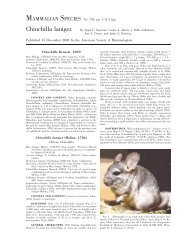Brugia Malayi - Clark Science Center - Smith College
Brugia Malayi - Clark Science Center - Smith College
Brugia Malayi - Clark Science Center - Smith College
Create successful ePaper yourself
Turn your PDF publications into a flip-book with our unique Google optimized e-Paper software.
Tree Hazard Ratings at the <strong>Smith</strong> <strong>College</strong> Arboretum<br />
Jennifer Rioux<br />
The campus of <strong>Smith</strong> <strong>College</strong> is made beautiful by trees of all sizes. The same trees that beautify our campus can become<br />
significant hazards when in declining health. It was recommended by a lawyer that the botanic garden set up a system to ensure<br />
every tree on campus be thoroughly inspected on a regular basis to protect against accidents such as a limb falling on a pedestrian<br />
or a car. Systems for inspection have been created in the past but none fully met the needs of the botanic garden. The new rating<br />
system used was based off of tree hazard-rating methods from other arboretums and past botanic garden intern work. It was<br />
determined that rating trees using the USDA community tree risk evaluation form would be most useful to the staff of the botanic<br />
garden. This system rates the trees on a three to twelve point scale through four sections. The sections are probability of failure,<br />
size of defective parts, probability of target, and other risk factors. The ratings of these sections add up to a total score indicating<br />
the level of danger the tree poses. Thirty trees were rated to test the system this summer. The trees chosen for the sample were<br />
some of the least healthy trees on campus. Their ratings ranged from five to twelve. The tree with the terrifying rating of twelve<br />
will be removed in the near future. It is completely hollow from decay. Once rated the trees were mapped using GIS software and<br />
can be easily viewed on a campus map. This map allows the botanic garden staff to visually see which trees need attention and<br />
when they need it most. This project is ongoing and will become even more useful as trees are added to the map. (Supported by<br />
the Schultz Foundation)<br />
Advisor: Michael Marcotrigiano<br />
References:<br />
Albers, J. S., Pokorny, J. D., & Johnson, G. (2003). Defective trees: Risk assessment guidelines. Urban tree risk management, 10(8), 1-9.<br />
Davison, E., & Brandt, B. (2009). Campus tree care plan. University of Arizona Campus Arboretum.<br />
Jonnes, J. (2011). What is a tree worth? The Wilson Quarterly.<br />
2012<br />
47

















